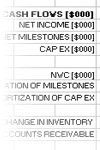|
 |
SG Systems
SG Systems is a
financial modeling and analysis firm with a focus on the
pharmaceutical and biotechnology industries.
SG Systems specializes in the quantitative and qualitative
evaluation of:
-
Discovery, early-mid-late phase, and marketed products
-
Product
portfolios
-
Firm equity
-
In-house
sales force versus licensing agreements
-
Mergers and
acquisitions
SG Systems' objective is to transparently value our clients'
projects, portfolios, products, technologies and companies
so the client can make very educated business decisions to
maximize their firm's value.
SG Systems' clients include multinational pharmaceutical
companies, companies developing pharmacological products,
companies distributing pharmaceutical products, as well as
manufacturing concerns.
SG Systems' typical projects include financial evaluation
and risk analysis of R&D projects, valuation of marketed
products, firm valuation in light of product values,
trade-off and sensitivity analysis, determination of
value-maximizing partnering and licensing conditions, and
the valuation of research and technology investments.
|